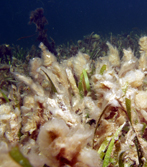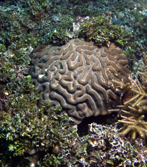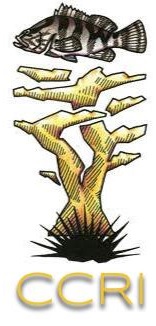
Nutrient enrichment of coastal waters stimulates the growth of algae beyond the capacity of grazers to control algal abundance. The source, nature and level of nutrient inputs determine the impact of eutrophication on coral reefs and other coastal marine communities. In the water column, phytoplankton can bloom and decrease light penetration, thereby reducing the photosynthetic capacity of the corals’ zooxanthellae. On the bottom, macroalgae and cyanobacteria can out-compete corals for space for recruitment and growth, leading to overgrowth, smothering and recruitment failure. Benthic algae also serve to trap sediments, further enhancing turbidity and smothering.
Several nutrient sources related to human activity may result in eutrophication of costal waters, such as domestic and agricultural sewage, agricultural fertilizers, runoff from golf courses and industrial pollutants. In February 2002, the Puerto Rico Aqueduct and Sewer Authority (PRASA) was charged with discharging raw sewage and other pollutants into navigable waters from 471 pump stations throughout the island of Puerto Rico and failing to properly operate and maintain the pump stations, among other violations. The intermittent and ongoing discharges posed serious threats to human health and the environment. Data from a November 2005 survey on submarine outfalls shows that coastal waters in the vicinity of the Aguadilla Regional Waste Water Treatment Plant (RWWTP) submarine outfall tend to retain their oligotrophic character despite the influence of effluent discharge. Other plants, such as the Ponce RWWTP have had problems that have resulted in the unauthorized discharges to marine waters. In June 2006, PRASA agreed to spend $1.7 million in improving wastewater treatments.

Rivers also represent a dominant source of sediment, bacteria and nutrient loading into Puerto Rico coastal waters. Naturally occurring events, such as hurricanes, influence the amount of river discharge resulting in extensive sediment and nutrient loading. The introduction of these nutrients, organic matter and other materials provide favorable conditions for the primary productivity of algae. After the pass of Hurricane Georges (1998), an estimated 1,000 metric tons of nitrate were discharged to the coastal waters of Puerto Rico, increasing phytoplankton biomass by at least two orders of magnitude. The Clean Water Act (CWA) 301 (h) program devised monitoring of influent and effluent water quality, receiving water quality, sediment quality, benthic invertebrate communities, fish and epibenthic invertebrate communities and coral community assessment.
References & more
- Chazottes V., Le Campion-Alsumard T., Peyrot-Clausade M., Cuet P. (2002) The effects of eutrophication-related alterations to coral reef communities on agents and rates of bioerosion (Reunion Island, Indian Ocean). Coral Reefs 21: 375-390
- Fabricius K. (2011) Factors determining the resilience of coral reefs to eutrophication: a review and conceptual model. In Dubinsky Z and Stambler N (eds): Coral Reefs: An Ecosystem in Transition. Springer pp. 493-505
- Pastore M. (2014) The impact of nitrogen eutrophication on Caribbean coral reefs: a review. CONCEPT XXXVII. 12pp.
